This was published 4 months ago
‘It’s a bit dismal’: How do you save a high street like Glebe Point Road?
On a stifling summer Saturday in February 2023, while the rest of the city was at the beach, dozens of residents, business owners and local politicians packed into Glebe Town Hall to bang heads on a wicked problem: the death of the high street.
COVID-19 was in the rearview mirror and people wanted their buzzy main drag back to full glory. But Glebe Point Road – a long strip from the bustle of Broadway to the foot of Rozelle Bay – was a shadow of its former self. And the pandemic wasn’t to blame.
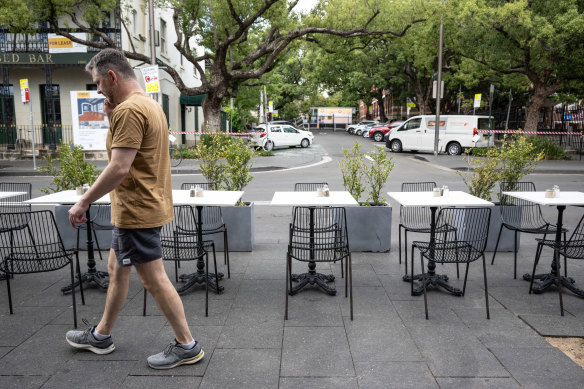
Glebe Point Road on Friday morning.Credit: Wolter Peeters
A year later, not much has changed. Like many other Sydney suburbs, Glebe’s high street has its highlights. However, it doesn’t know what it wants to be, the nights are dire, and it lacks a champion. “There’s no buzz,” says Catarina Isola, who owns the Wedge cafe. “It’s an incredible place, it’s special. I just don’t understand why we can’t bring back the life and the energy it once had.”
Isola has run The Wedge for 11 years and lives nearby. She says the decline of Glebe Point Road began about seven years ago, well before COVID-19, and blames a confluence of factors: empty shops, greedy landlords, an exodus of students, expensive housing, youth crime, a lazy City of Sydney council and a community resistant to change.
Long an eclectic mix of artists, students, public housing and grand Federation homes, Glebe has been hit particularly hard by changes at nearby universities. Online lectures mean students no longer need to come to campus as often. The cost of living, especially housing, also cuts away at students’ leisure. Time they might have once spent poring over textbooks at cafes or socialising with friends at bars is now more likely spent working to pay the rent.
“I remember back in the day, lunchtime at the Wedge was like a uni tutorial, there was so many of them,” Isola says. These days, she says, it’s mostly the international students who come. “They can actually afford it. There’s hardly any local students.”
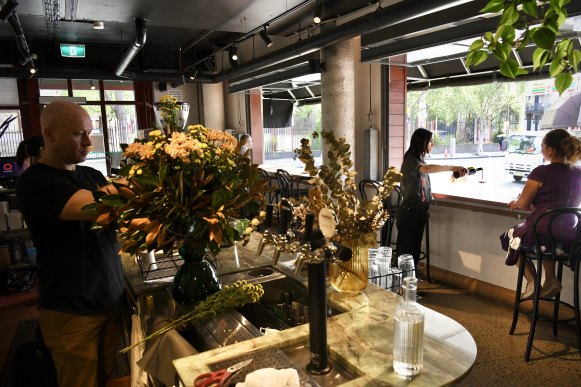
Catarina Isola pours a glass of wine at her café and restaurant, The Wedge, on Glebe Point Road.Credit: Dean Sewell
In addition to shopping centres like Broadway, Glebe Point Road has to compete with places such as Newtown’s King Street, the Central Park precinct and Redfern. It’s not all bad: the area around the Little Guy bar goes well, the Dirty Red cafe is a hit, and Saturday mornings are heaving thanks to the market at Glebe Public School – a Gen Z magnet. But other parts of the strip are plagued by vacant shopfronts, some of which have been empty for years or even decades.
That’s a problem confronting many Sydney high streets, such as Oxford, Darling and Norton. All share something in common: landlords seeking impossibly high rents who are happy to let their properties remain empty otherwise and a system that can’t do much about it.
“Because it’s a high street, they think that they can ask as much as they want,” says Isola. “But they don’t actually understand the business, the costs, and what it takes to run a business and then pay the rent they’re asking for, which is not viable. They’ve lost touch with the reality of the foot traffic that has diminished on this road.”
The Wedge occupies a prominent corner on the Broadway end of the high street. About 18 months ago, Isola finished a renovation and started opening nights, too, from Thursday to Sunday. She has since cut that back to Fridays and Saturdays only due to low demand. “Our dinner trade is dismal, but I’m not giving up,” she says.
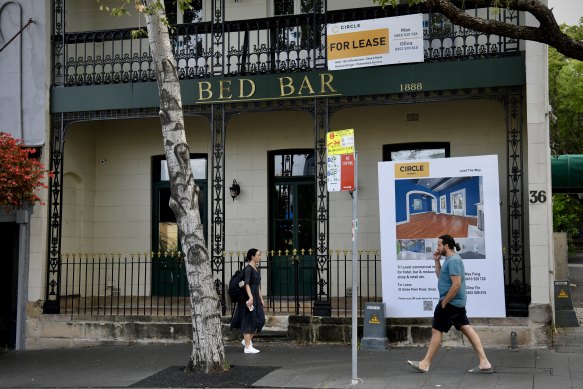
This corner terrace on Glebe Point Road has hosted a string of bars and live music venues that have failed.Credit: Dean Sewell
She’s not alone. On the next block, iconic cafe Badde Manors shuttered after the financial double whammy of the pandemic and a fire. It was revived in early 2023 by Jacqui Leonard, who tried to maintain the venue’s liquorless nighttime trade for six months, to no avail. As well as changing student behaviour and the economic crunch, she blames the long tail of Sydney’s lockout laws.
Across the road, a large terrace currently for lease has played host to several ill-fated live music ventures, including BED BAR, whose name is still emblazoned on the building. Next door, Soul Garden cafe has announced it will close on March 11.
“It’s a bit dismal,” says Leonard. There’s the D-word again. “Nobody wants to go somewhere that appears dead or has no energy.”
This Saturday, the City of Sydney council will throw a street party on Glebe Point Road. The event is part of a rotating series of events around town conceived during the pandemic to strengthen local businesses. The Glebe iteration has been poorly attended in the past, although Lord Mayor Clover Moore said the most recent one drew large crowds.
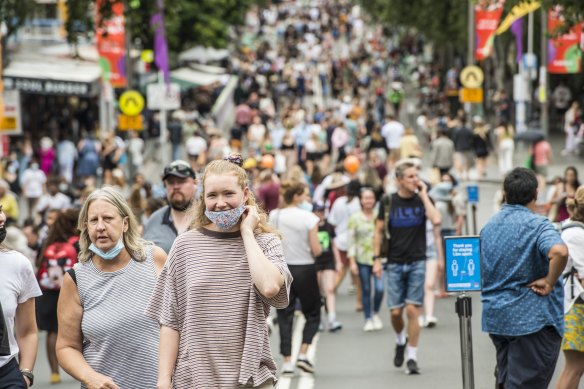
The Glebe street fair in February 2022.Credit: Steven Siewert
Isola says the parties succeed in precincts that are already alive, such as Darlinghurst’s Stanley Street. Leonard, meanwhile, scoffs at the council’s fondness for more on-street outdoor dining infrastructure. “The cafes are empty!” she says. “God only knows why they’re providing more outdoor seating for people who aren’t coming.”
The two business owners want the council to focus on getting vacant shops filled, while Leonard says lighting the trees at night would help make the strip more inviting.
Moore said the council did not support lighting trees due to concerns about damage from cables and fixings, and safety issues for workers who maintain the trees. She said landlords may keep their properties vacant for a number of reasons – leasing it at below-market rates may lower its value – and the council could not compel landlords to lease their properties.
“There’s no silver bullet to ensuring our high streets thrive in the face of changing consumer behaviour and demographics,” Moore said. She noted the council finished a $15 million upgrade of Glebe Point Road in 2009, and had an ongoing public works program to improve high streets.
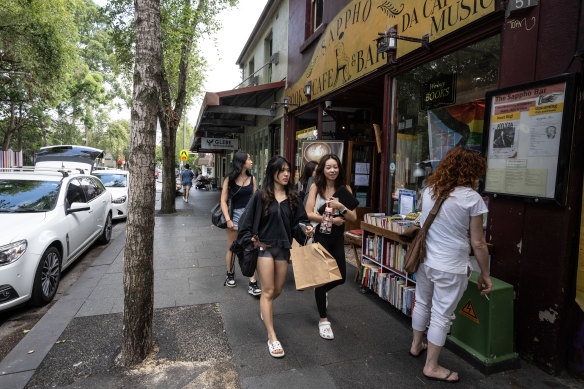
Glebe Point Road has some stalwart businesses, including Sappho book store and cafe, and Gleebooks.Credit: Wolter Peeters
“The city does all it can to protect and enhance these important commercial spines,” Moore said. “We continue to work with business owners in Glebe to address their concerns and look at ways we may be able to activate the street and support business.”
There is another way to bring more people to your high street: let them live there. The British government identified more housing as a key pillar of revitalising its high streets and rebuilding from the pandemic. A report on the matter contained a foreword by no less than the then-prime minister, Boris Johnson, also a former mayor of London.
Inner West Mayor Darcy Byrne has said more shop-top housing can help high streets, and their suburbs, to thrive. But in Glebe, that is tricky. Land is expensive, and the lots can be small. The entire street – virtually the whole suburb – is a heritage conservation area. And the idea of more apartments in the heart of the village would be anathema to many locals.
Last week, a development application was published showing plans for a seven-storey student co-living building on the grimy corner of Broadway and Glebe Point Road, opposite University Hall. It would contain 120 rooms, shared living spaces, retail and commercial areas and a gym.
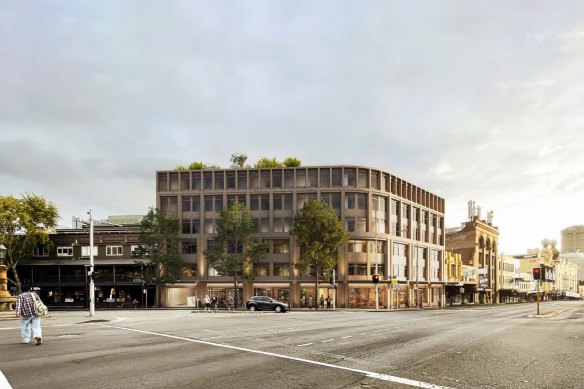
An impression of a student co-living development proposal at the corner of Broadway and Glebe Point Road.Credit: City of Sydney planning portal
Leonard and Isola say more residential development would be a welcome addition to Glebe. “I think it would be fantastic,” says Leonard. “We have a housing problem. There are certain areas that lend themselves to medium density. Obviously, it has to be sympathetic. I see a lot of second floors that are vacant or underutilised or in very poor shape.
The Greens’ Kobi Shetty, now the state MP for Balmain, which includes Glebe, attended the public meeting last year. She agrees that increasing density “in a thoughtful and strategic way” can be part of the solution to the high street’s woes and notes that the Aboriginal Housing Office has adapted and reused heritage properties on Glebe Point Road.
“Encouraging thoughtfully designed, mixed-use developments along our high streets could absolutely breathe new life into them,” Shetty says. “I’d support gentle infill at the rear of heritage blocks, as well as increased height along Glebe Point Road with appropriate setbacks to maintain street frontage and character.”
What we don’t need, she says, are more shopping centres dominating the economy and “sucking the life out of our village centres”.
Shetty also wants the government to allow councils to levy landlords who leave their property sitting vacant - something previous premiers have rejected. “Empty shopfronts are an issue right across the inner west,” she says. “Councils are keen to tackle this issue, but the state government needs to step in and give them the power to do it.”